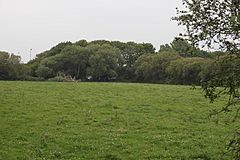Down End Castle facts for kids
Quick facts for kids Down End Castle |
|
|---|---|
| Dunball, Puriton, Somerset, England | |
 |
|
| Coordinates | 51°10′03″N 2°59′32″W / 51.1674°N 2.9921°W |
| Type | Motte and bailey |
Down End Castle is an old castle site in Somerset, England. It's also known by other names like Downend Castle or Chisley Mount. This castle was a special type called a motte-and-bailey castle. Today, it's a protected historical site, which means it's important and kept safe for future generations to learn about.
Contents
Discovering Down End Castle
Down End Castle is located near Dunball in Puriton, Somerset, England. It was built with a unique design that was common for castles of its time. The castle has a large mound, called a motte, and two flat areas next to it, called baileys.
What is a Motte and Bailey Castle?
A motte-and-bailey castle was a simple but strong type of castle.
- The motte is a big earth mound, like a small hill. A wooden or stone tower would sit on top of it.
- The bailey is a fenced-off area at the bottom of the motte. This area would hold buildings like stables, kitchens, and homes for soldiers.
- These castles were quick to build, often using earth and wood.
At Down End Castle, the main mound is about 30 meters (100 feet) wide at the top. The two bailey areas are to the north of this mound. The inner bailey had one protective bank, and the outer bailey had two banks for extra defense. There was even a natural spring at the bottom of the motte that supplied water to the castle!
When Was Down End Castle Built?
Experts believe Down End Castle was built around the year 1100. This was after the Normans took over England in 1066. After the Normans arrived, there were some rebellions, but by 1100, the area around Somerset had become more peaceful.
The castle was built in a very smart location.
- It was close to the River Parrett, which was an important river for trade back then.
- The castle also sat on a natural ridge, a raised strip of land.
- Several small streams nearby added to its natural protection.
The de Columbers family likely built this castle. They also built another nearby castle called Stowey Castle. When archaeologists dug at Down End Castle in 1908, they found pottery and iron objects from the Norman period. These items were similar to those found at Castle Neroche, another castle built around the same time.
What Happened to Down End Castle?
In 1225, Down End became a new town. It might have even been a settlement and port as early as 1159. The de Columbers family were important landowners in the nearby area of Puriton during the late 1100s.
However, Down End soon faced a big challenge. A new town and castle, Bridgwater and Bridgwater Castle, were built nearby. Bridgwater became a very successful port, and Down End couldn't compete. Over time, Down End declined and lost its importance.
Today, only the earthworks of Down End Castle remain. These are the mounds and ditches that show where the castle once stood. It is now a protected historical site, ensuring its remains are preserved for future generations.


